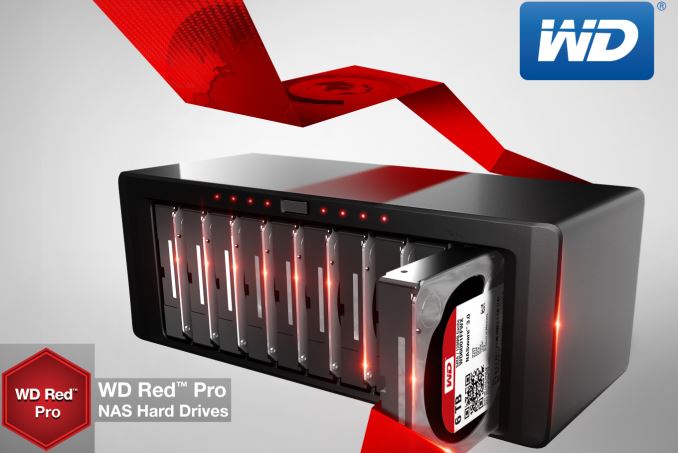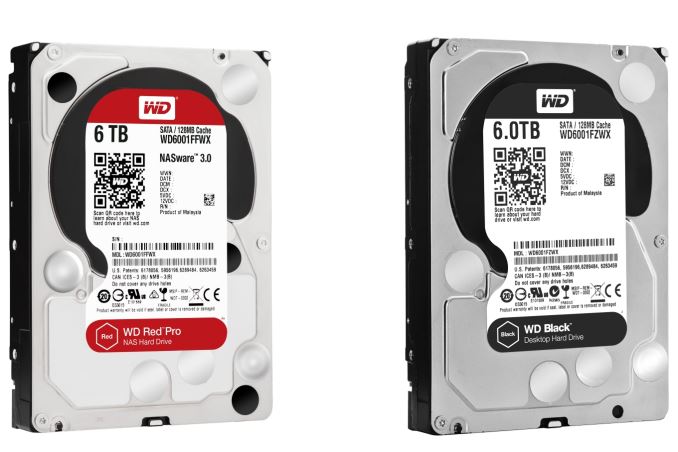Western Digital Updates WD Red Pro and WD Black with 5 & 6TB Models
by Ganesh T S on August 18, 2015 8:00 AM EST- Posted in
- NAS
- Storage
- Western Digital

It is that time of the year when Western Digital updates their Red lineup. Launched in 2012, the WD Red drives target network attached storage units with an optimized set of features for SMB / SOHO NAS units (up to 8 bays). It was initially launched in 1, 2 and 3TB capacities. In 2013, we saw a 4TB variant being added to the lineup along with some 2.5" drives. 2014 saw the addition of a Pro lineup (2,3 and 4TB) intended for use in NAS units with up to 16 bays. A 6TB Red version was also introduced. This year, we get 5 and 6TB WD Red Pro units. In addition, WD is also launching 5 and 6TB WD Black drives targeting gamers and creative professionals with a need for large capacity and high performance.
The important features of the WD Red Pro drives being announced today include:
- 128 MB cache
- Transfer rates up to 214 MBps
- Vibration tolerance and shock protection using a multi-axis shock sensor and dynamic fly-height technology
There doesn't seem to be any updates to the firmware (NASware 3.0, introduced last year, is retained). The Red Pro drives carry a 5 year warranty. The WD Red Pro 5TB version (WD5001FFWX) has a MSRP of $269, while the 6TB version (WD6001FFWX) is priced at $299. In terms of MSRP, this seems to be lower than the Seagate Enterprise NAS HDD by $50.
The WD Black is Western Digital's desktop hard drive lineup with a focus on performance. Similar to the WD Red Pro, the Black lineup is also getting 5 and 6TB members priced at $264 and $294 respectively. These drives also have a 128 MB cache and spin at 7200 RPM (just like the WD Red Pro units). While WD didn't provide hard performance numbers, the press release indicates that the 6TB version is 29% faster than the WD Black 4TB in terms of maximum data throughput, while scoring 10% more in PCMark Vantage. It also comes with a 5-year warranty.











51 Comments
View All Comments
creed3020 - Tuesday, August 18, 2015 - link
I would like to have seen an update to the 2.5" lineup of drives. With Seagate already shipping a 4TB 15mm z-height 2.5" drive, smaller form factor NASes are quickly becoming a reality.ddriver - Tuesday, August 18, 2015 - link
How does NAS benefit from small form factor? Network attached implies non-portability. 2.5 inch drives cost more and offer lower capacity.DanNeely - Tuesday, August 18, 2015 - link
The same way other computing devices benefit. They consume less power and take up less space. How much these matter depends on circumstances. The perspective of a single person in a big home (or just one that looks like a computer store) living somewhere where electricity costs 10c/kWh is very different than that of someone married to a mundane living in a very small apartment and paying 40c/kWh.ddriver - Tuesday, August 18, 2015 - link
Hmm, is that statement true? It depends quite a lot.Let's say, you need 8 TB of storage. You could achieve that with a single 3.5 drive, or 4 2.5 inch drives. I don't find 2.5 drives with capacity higher than 2 TB in nearby retailers or newegg. And surely, anything more will for the time being come at a hefty price premium.
I am not convinced that 4 x 2.5 inch drives will neither take less space, nor use less power, nor produce less noise, nor release less heat than a single 3.5 inch drive.
On top of that, you increase the price significantly, and also the risk of failure quadruples if you combine them in a single volume.
Now, I assume when we are talking NAS we are talking more capacity than the storage you will get in a typical consumer device. Since 2.5 inch drives come in lower capacities and at higher cost, I really don't think it is worth it. Those drives are meant to go into portable devices, and NAS is not that.
modulusshift - Tuesday, August 18, 2015 - link
That's exactly what the update would address, were it to happen.name99 - Tuesday, August 18, 2015 - link
WD sell 3TB 2.5" external drives. (My Passport Ultra)For some strange reason they do not (yet?) appear to sell these same drives as bare drives.
ddriver - Tuesday, August 18, 2015 - link
That's because they are thicker and would not fit where 2.5 inch drives are supposed to.Daniel Egger - Saturday, August 22, 2015 - link
Sure, that all depends on the capacity you need. For some strange reason everyone seems to assume that only the highest available capacity is the one everybody wants/needs. There're many applications where that is in incorrect assumption which is also supported by the fact that almost no one is rebuilding all their RAID arrays with every new size coming out...Using smaller capacity (but more) drives can have a lot of advantages including price, reliability, more suitable data partitioning and potentially performance, faster RAID rebuilding, more RAID level options etc. ... so it *ALWAYS* depends on the specific usecase.
In our data center we're currently using mostly 2TB 3.5" drives (+ 2.5" SSDs) right now with no intention to upgrade to 8TB, personally I'd never use anything else than SSDs and 2.5" HDDs for storage anymore.
Samus - Wednesday, August 19, 2015 - link
It's like the ITX arguement. Like women's clothing, the smaller it is, the more expensive.I personally think 4 bay 2.5" NAS with 16TB of storage in something the size of a loaf of bread using <20 watts is pretty amazing.
The same way those new X99 ITX boards are just amazing. The amount of power in something that can fit in a shoebox is remarkable.
eek2121 - Monday, August 24, 2015 - link
I don't get it...I have an 8 bay NAS that holds 3.5" drives, and it's the size of a loaf of bread...or are you getting confused again?